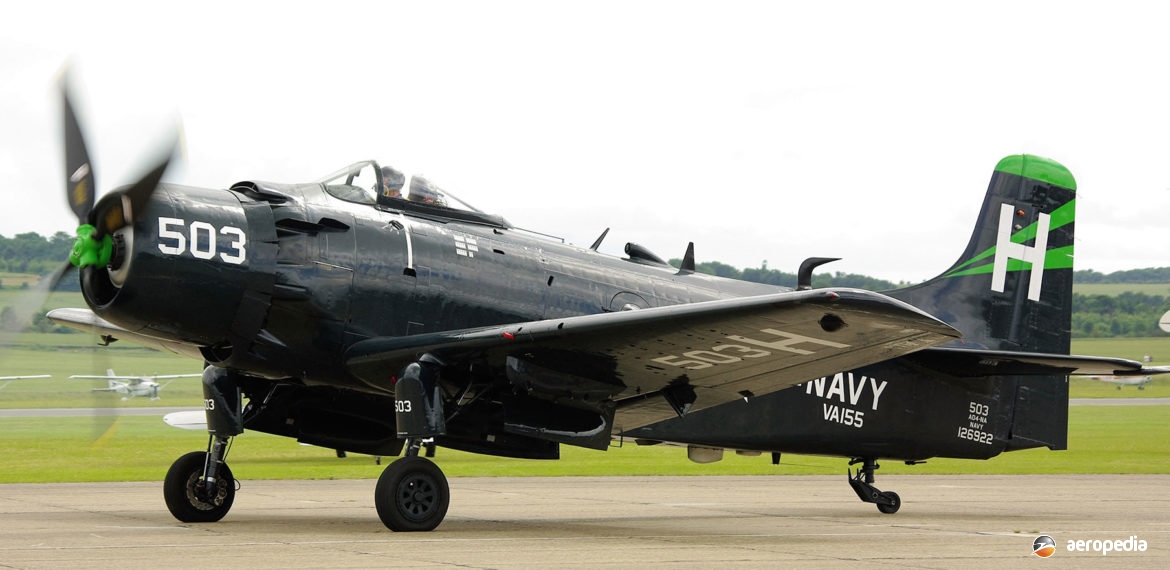Photograph:
Douglas AD-4NA Skyraider 51-26922 G-RADR at Duxford, UK in July 2012 (David C Eyre)
Country of origin:
United States of America
Description:
Shipboard-based dive-bomber and torpedo-bomber
Power Plant:
(Douglas AD-5)
One 2,014 kw (2,700 hp) Wright R-3350-26WB Cyclone eighteen-cylinder two-row air-cooled radial engine
Specifications:
- Wingspan: 15.51 m (50 ft 9 in)
- Length: 12.22 m (40 ft 1 in)
- Height: 4.84 m (15 ft 10 in)
- Wing area: 37.19 m² (400.33 sq ft)
- Max speed at 5,486 m (18,000 ft): 500 km/h (311 mph)
- Cruising speed: 322 km/h (200 mph)
- Initial rate of climb: 701 m/min (2,300 ft/min)
- Ceiling: 7,925 m (26,000 ft)
- Range: 1,934 km (1,202 miles)
- Empty weight: 5,585 kg (12,313 lb)
- Loaded weight: 8,527 kg (18,799 lb)
- Max loaded weight: 11,340 kg (25,000 lb)
Armament:
Four 20 mm M3 cannon in the wings; ordnance up to 3,629 kg (8,000 lb) carried on one under-fuselage and 14 under-wing hardpoints
History:
The Douglas XBT2D-1 was designed in the early 1940s and was first flown in prototype form (Bu Aer 09086) on 18 March 1945 by LaVerne Brown, the type entering service as the AD-1 in 1946, commencing service in the Korean War with the US Navy and US Marine Corps. It later went on to see service in the Vietnam War. It was designed by a team headed by Ed Heinemann to replace the Curtiss SB2C Helldiver, and was initially known as the BT2D-1 Dauntless II. It was a single-seat, folding-wing, dive-bomber and torpedo-bomber designed around the 1,716 kw (2,300 hp) Wright R-3350-24 radial engine. All stores were carried externally, there being no bomb-bay provided.
Douglas was requested to convert two aircraft to night-attack models, known as the XBT2D-1N, with provision in the rear fuselage for two further crew members, a radar operator/navigator, and a radar countermeasures operator. In February 1946 the new design became the Skyraider, and in April that year it was re-designated the AD, becoming the AD-1 series in 1962. Variants built were from the AD-1 to the AD-7, later known as the A-1D to the A-1J, and there were many sub-variants of each model to meet service requirements.
The Model AD-2 was introduced in 1948 with increased fuel capacity to 1,892 litres (416 Imp gals), some of these being converted to AD-2D remote controlled drones. The Model AD-3 had a longer undercarriage, 173 being delivered as the AD-3E and AD-3S for anti-submarine work; the Model AD-3N for night attack; the Model AD-3Q for countermeasures; and the Model AD-3W for airborne early warning. The Model AD-4 was the mainstay of the US Navy attack aircraft in the Korean War, and variants of this series were supplied to the Royal Navy as the AEW.1. These were operated during the Suez crisis in 1956.
More than 800 examples of the Model AD-4 series were built at the El Segundo facility in California in a variety of sub-variants, and this series saw combat with French forces in Algeria, Chad and Madagascar in the 1970s. Some of these were later transferred to the Cambodian Air Force in 1965. The Model AD-5 differed in having a new crew area, the fuselage being lengthened and provision being made for side-by-side seating in the cockpit, this variant seeing service with USAF units in Vietnam,. More than 700 examples were produced.
The Model AD-6 was an improved AD-4B and 713 examples were delivered. The first Model AD-7 (Bu Aer 142081) was the last piston-engined bomber built for the US military, the last being delivered on 18 February 1957. In the mid 1960s the US Navy had decided to replace the Skyraider with the Grumman A-6 Intruder. Two US Navy Skyraider pilots were credited with shooting down North Vietnamese MiG-17s during that conflict. The last Skyraiders with the US Navy were retired in 1968.
A total of 3,180 Skyraiders was completed, of which some 54 have survived in museums and private collections. Some 22 ha ve been airworthy and privately owned in France, the United States and the United Kingdom.
A few Skyraiders were seen over the years in Australia when United States Navy aircraft carriers and their crews visited Australian ports for rest and recreation. In 1959 during exercises with the Royal Navy, a Royal Navy Skyraider AEW-1 [WT945] operated by No 849E Squadron was flown onto and operated for a short period from ‘HMAS Melbourne’.
The first of the type seen in New Zealand was in 1954 when the ‘USS Tarawa’ visited.
It was mooted at one stage an example of the type was to be imported to Australia to become a warbird in early 2006 for restoration to airworthiness but this did not take place.
An example was expected to arrive late in 2012, this aircraft being obtained for the National Vietnam Veterans Museum on Phillip Island, VIC for display in its museum. The machine donated was an AD-4NA (Bu Aer 127894 – c/n 7909) which was last operated as No 68 with the French Armee de l’Air from 1959. In 1966 it was transferred to the Gabon Air Force as 127894 / TR-KFQ. In 1971 it was allotted the American registration N92072 to an owner in Detroit, Michigan but the registration was not taken up and the aircraft was not delivered, remaining in storage in France between 1977 and 1985. In that year it was conveyed to the South African Air Force Museum at Ysterplaat where it was placed in storage until obtained by the NVVM. However, by early 2021, the aircraft had still not arrived on Australian shores.

